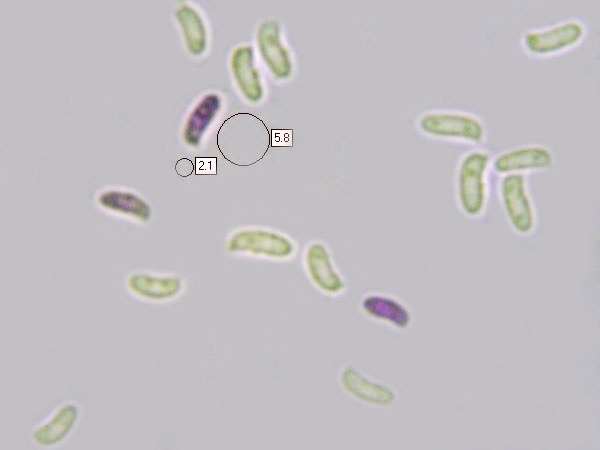Trichaptum abietinum (Dicks.) Ryvarden - Purplepore Bracket
Phylum: Basidiomycota - Class: Agaricomycetes - Order: Polyporales - Family: Polyporaceae
Distribution - Taxonomic History - Etymology - Identification - Culinary Notes - Reference Sources
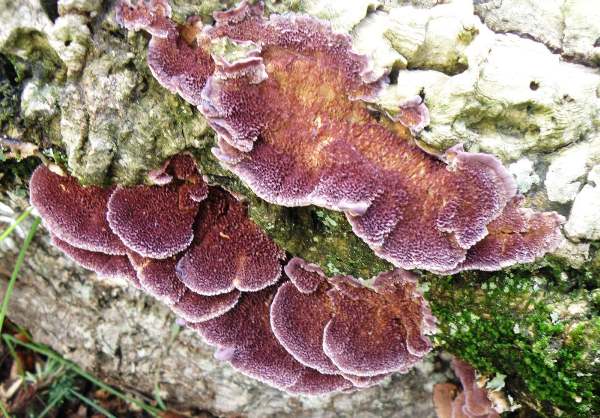
When tinged with purple, the pore surface of this smallish but gregarious annual bracket fungus is very distinctive; however, sometimes the pore surface is brown with hardly a hint of purple. The variable shape - sometimes resupinate but more often sharply reflexed (bracket like) can cause confusion too.
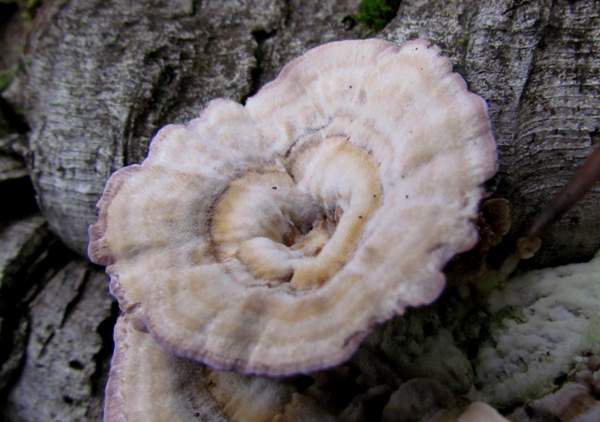
Distribution
Purplepore Bracket is frequent and widespread in Britain and Ireland as well as most of Europe.
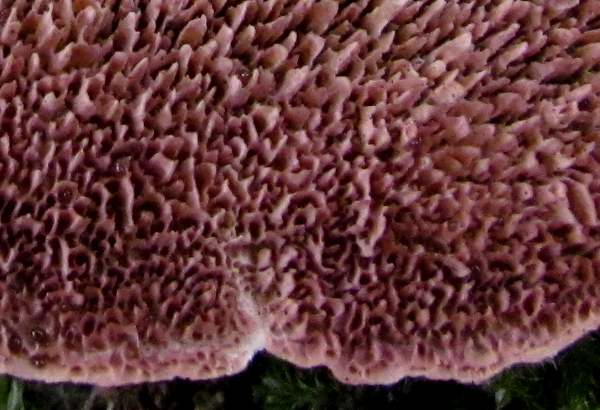
In parts of North America where this colourful bracket fungus is also fairly common and widespread, it is often referred to as the Violet-pored Bracket.
Taxonomic history
The basionym of this polypore dates from 1793, when it was described scientifically by British naturalist Dickson, who gave it the binomial scientific name
The currently-accepted scientific name Trichaptum abietinum dates from a 1972 publication by the Norwegian mycologist Leif Randulff Ryvarden (b. 1935).
Synonyms of Trichaptum abietinum include Boletus abietinus Dicks., Polyporus abietinus (Dicks.) Fr., Polystictus abietinus (Dicks.) Cooke, Hirschioporus abietinus (Dicks.) Donk, and Trametes abietina (Dicks.) Pilát.
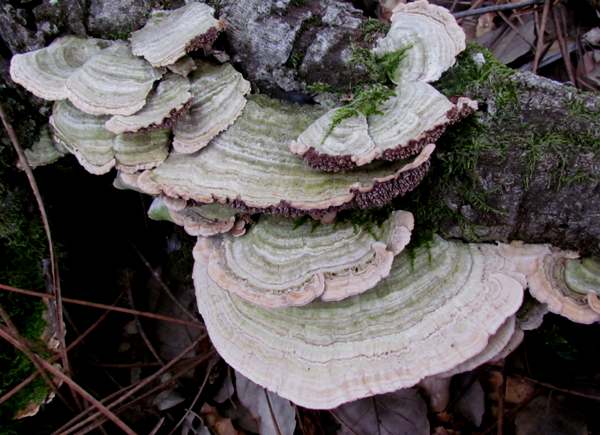
Etymology
The generic name Trichaptum means 'with clinging hairs', and the specific epithet abietinum means 'inhabiting fir trees' (trees of the Abies genus), although this wood-rotting bracket will also attack other kinds of conifers and, very occasionally, some hardwoods too..
Identification guide
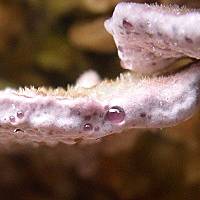 |
Infertile surfaceIndividual caps grow to between 1 and 5cm in diameter and are typically 1 to 4mm thick. Often growing in tiers and fusing together laterally, the stemless caps are broadly attached to the host tree. The upper surface is lumpy and covered in fine hairs; it is concentrically zoned in shades of grey and light brown tinged with purple, and often stained green with algae especially near to the attachment region. The cap fles is whitish. This fungus also grows in resupinate or semi-resupinate form when on the underside of felled trunks or branches. |
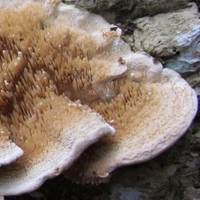 |
Fertile surfaceA beautiful bright violet or purple at first, gradually fading to ochraceous with the purple tones restricted mainly to the margin. Pores are spaced at 2 - 4 per mm, becoming increasingly tooth like as the fruitbody matures. |
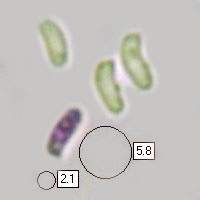 |
SporesOblong-ellipsoidal, sometimes slightly allantoid (sausage-shaped), smooth, 6-7.5 x 2-2.5µm; hyaline, inamyloid. Spore printWhite. |
Odour/taste |
Not significant |
Habitat & Ecological role |
Saprobic on dead timber of conifers, particularly firs and spruces; very occasionally reported to occur on dead wood of broadleaf trees. Brackets are annual but regrowth upon old brackets can also occur. |
Season |
Seen throughout the year. |
Similar species |
Could be confused with Trametes versicolor when seen from above. The closely related Trichaptum fuscoviolaceum is very rare in Britain. |
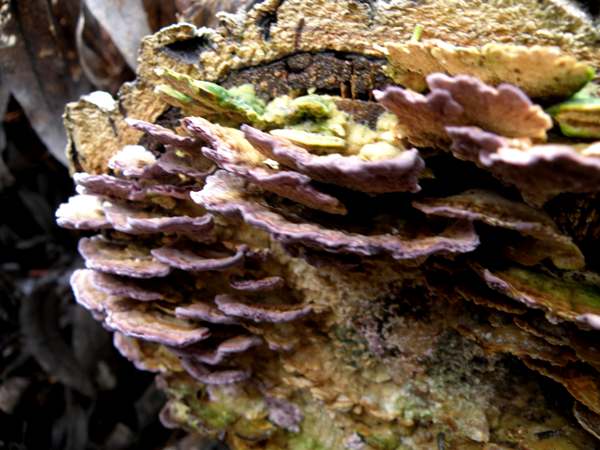
Culinary Notes
Like so many bracket fungi, this polypore is too tough to be considered edible. We have no information about any possible toxin content.
Reference Sources
Pat O'Reilly (2016). Fascinated by Fungi, First Nature Publishing
Ellis, M.B. & Ellis, J.P. (1990). Fungi without Gills (Hymenomycetes and Gasteromycetes). Chapman and Hall: London.
Paul M. Kirk, Paul F. Cannon, David W. Minter and J. A. Stalpers. (2008). Dictionary of the Fungi; CABI.
Mattheck, C., and Weber, K. (2003). Manual of Wood Decays in Trees. Arboricultural Association
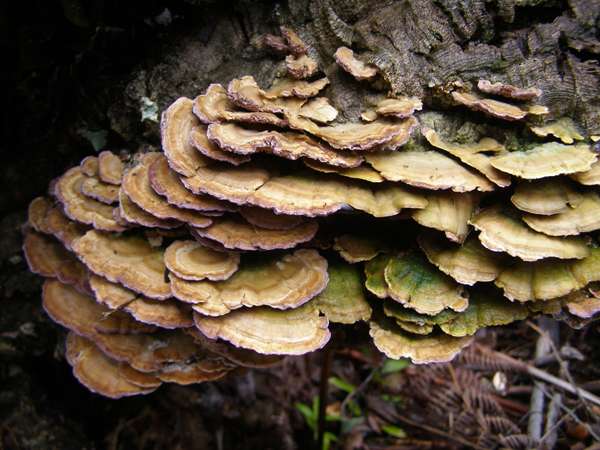
Taxonomic history and synonym information on these pages is drawn from many sources but in particular from the British Mycological Society's GB Checklist of Fungi.
Fascinated by Fungi. Back by popular demand, Pat O'Reilly's best-selling 450-page hardback book is available now. The latest second edition was republished with a sparkling new cover design in September 2022 by Coch-y-Bonddu Books. Full details and copies are available from the publisher's online bookshop...
